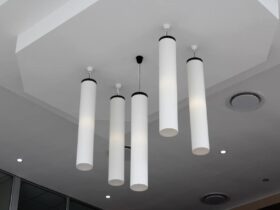The coffee table is an indispensable piece of furniture in our homes, serving as both a practical surface for beverages and a design element that ties together the aesthetics of a room. One critical aspect of coffee table selection that often goes overlooked is its height. The average height of a coffee table plays a crucial role in its functionality and how it complements your living space. In this article, we will delve into the world of coffee tables, exploring their heights, the factors that influence them, and how to choose the perfect height for your needs.
What Is The Average Height Of A Coffee Table?
The average height of a coffee table typically ranges from 16 to 18 inches (40 to 46 centimeters). However, variations exist, and coffee tables can be as low as 12 inches (30 centimeters) or as tall as 24 inches (61 centimeters). The ideal height depends on factors like seating arrangement, functionality, and personal preference, so it’s essential to choose a height that suits your specific needs and style.
Understanding Coffee Tables
Understanding coffee tables involves recognizing their essential role in both interior design and everyday life. Coffee tables are versatile pieces of furniture designed to serve as a functional and aesthetic centerpiece in a living room or lounge area. These tables are strategically placed within seating arrangements to provide a convenient surface for placing beverages, snacks, reading materials, or decorative items.
Moreover, coffee tables are not just about utility; they play a significant role in defining the overall look and feel of a room. Their design, size, and, importantly, their height, contribute to the harmony and balance of the space. They can act as focal points, enhancing the visual appeal of the room while also creating a comfortable and welcoming atmosphere.
Coffee tables have evolved over time, adapting to changes in design trends and user preferences. Today, they come in various styles, materials, and shapes, allowing homeowners to select options that best complement their interior decor. As such, understanding coffee tables involves appreciating their dual function: practicality, and aesthetics, and how these aspects intertwine to create a harmonious living space.
Factors Influencing Coffee Table Height
Several factors influence the height of a coffee table, making it a critical consideration when choosing the right one for your space. These factors include:
- Seating Arrangement: The primary factor influencing coffee table height is the seating arrangement it complements. For instance, a coffee table for a standard sofa should generally have a height that aligns with the seat cushions or is slightly lower. This ensures ease of access to items on the table while maintaining a visually pleasing balance.
- Functionality: The intended use of the coffee table plays a significant role in determining its height. If you plan to use it primarily for dining or working, you may opt for a taller table, while a lower height may be preferable for casual lounging or to achieve a more open and airy look.
- Design and Style: The overall design and style of your room can influence the coffee table’s height. Modern or contemporary interiors often favor lower coffee tables for a sleek, minimalist appearance, while traditional or rustic styles may feature taller tables that exude a sense of grandeur.
- Personal Preferences: Your personal preferences and comfort matter when selecting a coffee table height. Consider what feels most comfortable for you and your family. If you frequently entertain guests, their preferences should also be taken into account.
- Customization: Coffee tables come in a range of heights, but sometimes, none may fit your specific needs perfectly. In such cases, opting for custom-made or adjustable coffee tables can provide the flexibility to tailor the height to your precise requirements.
Pros Of Different Coffee Table Heights
Low Coffee Tables:
- Contemporary Aesthetics: Low coffee tables can create a modern and minimalist look in your living space, making them ideal for contemporary interior designs.
- Lounge Feel: They promote a relaxed, casual ambiance, perfect for spaces where comfort and informal gatherings are prioritized.
- Visual Space: Their lower height can make a room appear more spacious and less cluttered, enhancing the sense of openness.
Standard Coffee Table Heights:
- Versatility: Standard-height coffee tables are compatible with most seating arrangements, ensuring broad usability.
- Accessibility: They strike a balance between form and function, providing easy access to items without compromising aesthetics.
- Widespread Availability: Standard-height coffee tables are readily available in various styles, making them accessible to a wide range of tastes.
Cons Of Different Coffee Table Heights
Low Coffee Tables:
- Limited Storage: Low coffee tables often lack space underneath, which can be a drawback if you require storage for books, magazines, or other items.
- Potential Discomfort: Bending down to reach items on a low coffee table can be uncomfortable for some individuals, particularly those with mobility issues.
Standard Coffee Table Heights:
- Lack of Uniqueness: Standard-height coffee tables, while versatile, may not stand out as unique or visually striking compared to tables with more extreme heights.
- Not Ideal for All Seating Types: They might not work well with certain seating options, such as low-slung sofas or lounge chairs, which require lower tables for optimal usability.
Adjustable Coffee Tables:
- Complex Mechanisms: Some adjustable coffee tables may have mechanisms that are less user-friendly or prone to wear and tear over time.
- Aesthetics in Transition: They might not always look visually appealing when adjusted to different heights, depending on the design.
Choosing The Right Coffee Table Height
Choosing the right coffee table height is a crucial decision that can significantly impact the functionality and aesthetics of your living space. Here’s a step-by-step guide to help you make an informed choice:
- Assess Your Seating Arrangement: Consider the type and arrangement of seating in your living area. Measure the height of your sofa or chairs from the floor to the seat cushions. Ideally, your coffee table should be at or slightly below this height for comfortable access.
- Determine the Primary Use: Identify the main purpose of your coffee table. Will it primarily serve as a surface for drinks and snacks, a spot for decorative items, or a functional workspace? Your intended use will influence the ideal height.
- Consider Aesthetic Preferences: Think about the overall design and style of your room. Low coffee tables lend a contemporary, minimalist look, while standard-height tables are versatile and can complement various styles. Taller tables may suit more traditional or formal settings.
- Evaluate Personal Comfort: Take your personal preferences and comfort into account. If you or your family members prefer a specific height for convenience, prioritize this aspect in your decision-making process.
- Room Layout and Traffic Flow: Analyze the layout of your room and the flow of traffic. Ensure that the coffee table’s height doesn’t obstruct walkways or disrupt the visual balance of the space.
Explore Adjustable Options:
Conclusion
In conclusion, selecting the right coffee table height is a pivotal decision in interior design, impacting both functionality and aesthetics. By considering factors such as seating arrangement, intended use, personal preferences, and room layout, you can ensure that your chosen coffee table height enhances the overall harmony of your living space. Whether opting for standard, low, tall, adjustable, or custom-made coffee tables, a well-thought-out choice will not only elevate the usability of the table but also contribute to the visual appeal of your home, creating a welcoming and comfortable environment for all.
FAQ’s
What Is The Ideal Height For A Coffee Table?
The ideal height for a coffee table typically ranges from 16 to 18 inches (40 to 46 centimeters). However, it should be aligned with the seat cushions of your seating or slightly lower for comfortable access.
Can I Use A Taller Coffee Table With A Low-Slung Sofa?
Yes, you can, but it may not be the most ergonomic choice. Taller coffee tables can work with low-slung sofas, but you might find it less comfortable when reaching for items. Consider adjustable options or prioritize comfort.
Are There Industry Standards For Coffee Table Heights?
While there are common height ranges for coffee tables, there are no strict industry standards. Coffee table heights can vary based on design trends and individual preferences.
What Are The Advantages Of An Adjustable Coffee Table?
Adjustable coffee tables offer versatility. You can raise them for dining, working, or serving purposes, and lower them for a more traditional coffee table function. They’re especially useful in small spaces.
How Do I Know If I Should Choose A Low Coffee Table For My Living Room?
Opt for a low coffee table if you want a contemporary and minimalist look, prefer a relaxed, lounge-like atmosphere, and are comfortable with the lower height. Ensure it complements your seating and overall room design.




















Leave a Reply